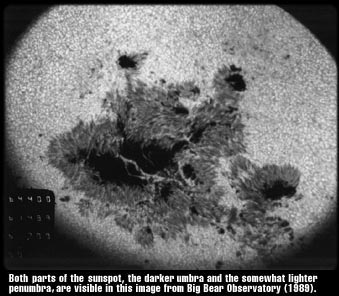|
|
|||||
|
The Sun's Magnetism |
|
||||
| The sun, like the earth, generates a magnetic field that extends out into space. However, the sun's magnetic field changes both its shape and intensity over the surface, and over time, much more rapidly. Why is that? We'll need to learn some basics about how the solar magnetic field works, to see how these fluctuations can cause sunspots. | |||
Magnetic fields from electrons Have you ever made a magnet by winding wire around a nail and hooking the ends to a battery? This works because moving electrons, like the electric current in the wire, generate a magnetic field. The magnetic field lines go through loops of wire and the nail, and the nail becomes a magnet. Something similar happens in the Sun. |
|||
In the Sun, the flows of hot plasma in the convection zone create the solar magnetic field. The plasma is a hot gas "soup" with many free charged particles (electrons and protons). The moving charges are a current, and produce magnetic fields, just like the current in coils of wire around the nail. What's different in the sun? The convection current is driven by the heat from the Sun's fusion, instead of a battery. |
|||
David Dearborn refers to the flows as the "solar dynamo," saying: "So there you have mechanical motion, and that mechanical motion is involved in generating the magnetic fields that cause sunspots." scientists like Dearborn believe that convection creates the varying magnetic field at the sun's surface, but the ultimate reasons for each fluctuation in the flows and fields are not well understood. The sun's rotation is also an important force. The next generation of solar scientists may unravel the workings of this immense powerhouse. |
|||
Sunspots are regions of very strong magnetic field, where the field lines get so crowded together that they push up through the surface, bringing some of the hot plasma with them in a spectacular arc, or loop. We see the end of the loop as a sunspot on the sun's visible surface, or photosphere. This dense bundle of field lines creates huge magnetic pressures. What is magnetic pressure? We know what pressure is in a gas: if you compress some gas, like squeezing a balloon, it tries to push out again. David Dearborn explains, "If you take those places where there are concentrations of magnetic field and put them together, they have pressure of their own. You can feel magnetic pressure when you take two magnets and take the ends of the same polarity and try to put them together. They just don't want to go together. That's magnetic pressure." The more the magnetic field lines are scrunched together, the more they want to push apart again. |
|||
 
|
Balance pressures to keep cool
|
Fisher says sunspots are still quite hot: "Instead of being about 5800 degrees Kelvin like the rest of the photosphere, the temperature of a sunspot is more like 4000 degrees Kelvin. But that is still very hot, compared to anything here on earth." This means the magnetic pressure inside the sunspot is so strong it can cool down a part of the surface of the sun by almost one third!
| Considerably darker Since sunspots are about one third cooler than the surrounding materials, they are much darker. Dearborn explains, "If you have a piece of gas or iron and you heat it up and ask how much light it emits, you can measure it. If you then double the temperature, the amount of light that's emitted...is almost eight times as much." In other words: |
 |
Small change in temperature = Big change in brightness
Reverse this process for a hot object being cooled, and it follows that while sunspots are moderately cooler they are much darker than other parts of the sun's surface.
|
|
|||||
|
|
|||||
|
©Copyright 2001 Regents of the University of California. |